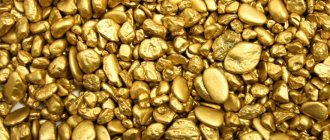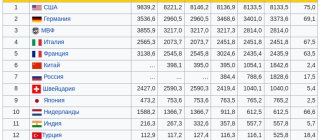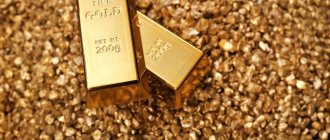According to data released by the World Gold Council (WGC), global gold production in 2021 was 3,478.1 tonnes (122.7 million ounces).
Volumes have declined for the second year in a row. In 2021, this figure was 3,561.3 tons, in 2021 - 3,533.7 tons.
“Experts believe that one of the reasons for the decline in gold production in the world is the negative impact of the new coronavirus pandemic on the economy,” says Top-RF.ru columnist Svetlana Baruzdina.
In addition, the budgets allocated by companies for geological exploration are being reduced.
Against this background, the list of countries included in the top 10 gold mining rankings has also changed in 2021.
See also: - 10 jewelry stores in Russia: favorite brands and manufacturers >>
Uzbekistan – 90 tons
Uzbekistan is one of only two landlocked countries bordering landlocked countries in the world, but that doesn't mean it doesn't have important natural resources (although there are definitely problems with exporting them ). This country took tenth place in the ranking of the most gold-mining countries, as about 90 tons of gold are mined here per year. Most of the gold that is mined here is then nationalized, and it belongs to the Navoi Mining and Metallurgical Combine.
To balance
The main gold reserves in Russia are concentrated in two regions: the Far Eastern Federal District and the Siberian Federal District. 50% falls on the Far Eastern Federal District - it has risen greatly due to administrative redistribution: gold-rich Buryatia and Transbaikalia are now also the Far Eastern Federal District. 36.4% of reserves are concentrated in Siberia; in other regions, accordingly, there are very few known promising deposits.
At the same time, TsNIGRI specialists identified the regions where new deposits are most actively being put on the balance sheet. In terms of the number of objects, the leaders are the Krasnoyarsk and Transbaikal Territories, the Amur, Irkutsk and Sverdlovsk Regions, and the Khabarovsk Territory. If you look at the volume of supplies that arrived in each region, the balance of power will change somewhat.
The leaders are again the Krasnoyarsk and Transbaikal Territories, the Chukotka Autonomous Okrug, the Khabarovsk Territory and the Amur Region. But the Sverdlovsk region gives a very small total increase, which means that the local objects are small. But in Chukotka it’s the other way around: there are only a few objects, but the contribution to the “common cause” is substantial. The main discovery is, of course, the Peschanka gold-copper deposit, where resources amount to 16.5 million tons of ounces of gold.
In 2021, 77 gold deposits were put on the state balance sheet: 62 alluvial and 15 primary. Details of the largest of them are presented in Table 1.
“Equipment for production laboratories must be adapted to specific tasks and the raw materials processed at the enterprise. For example, when regularly determining the concentration of gold in ore containing free gold, it is necessary to use the so-called technological method (gravity).
Moreover, the lower the gold content in such ore, the higher the error of conventional analysis and the greater the relevance of this approach, therefore, the equipment of the laboratory must be appropriate: the presence of concentrators for enriching the analyzed sample, the presence of high-quality pulp dividers, dividers for dry products of a relatively large volume ( tens of kilograms). Previously, technologies managed without this equipment, as well as without a modern analytical base.
To work with samples of gold-bearing ores, the approach described above is required: separation of large gold by gravity before analysis. Laboratories must have modern devices for dehydrating products - press filters or vacuum filters. In some cases, drying of products is impossible due to the large volume of material (long duration, difficulty in technically organizing drying), which significantly reduces the efficiency of working with the material; in addition, for some products, drying is undesirable due to a possible change in their properties during heat treatment.
For this reason, there is a need to divide and reduce the material in the form of pulp. The task is quite complex and impossible without specialized equipment, so the presence of a pulp divider is mandatory in a modern laboratory. For metallurgical laboratories of large enterprises, it is desirable to have various test equipment that simulates production processes.
The laboratory must be equipped with both individual devices (concentrators, flotation machines, reactors, leaching columns, mills for changing physical and mechanical parameters, etc.) and entire chains of equipment - pilot plants.
Such installations make it possible not only to determine benchmark indicators of processed ore, but also to improve existing processes, as well as obtain indicators for processing ores of promising extraction. It is important to note that a random set of devices will not allow solving these production problems; careful adaptation of the equipment and lines to the raw materials and circuit is necessary, and it is necessary to develop a methodological approach in each specific case.
The complication of the laboratory facilities and the rules for processing samples, of course, leads to an increase in the cost of studying materials, however, such expenses are justified because they allow one to reliably assess the technological properties of ore, correctly understand the parameters of production processes, which ultimately leads to an increase in product output and a decrease in its cost,” explained the chief engineer of Astra Technics LLC Maxim Nekryty.
Based on the results of the first quarter of 2021, the most significant increase in reserves occurred due to additional exploration of the flanks and deep horizons of the Svetlinskoye and Severnoye fields (Table 2).
Indonesia – 100 tons
Capricorns love classical music: the perfect first date for different signs
The 30-minute rule: how to eat apples correctly so that all the vitamins are absorbed
Pushkin's sister may have predicted the poet's sad fate
While you can find the largest open-pit gold mine in the world in Uzbekistan, the record for the largest gold mine belongs to Indonesia. We are talking about the Grasberg mine, where 19 thousand people work. Unfortunately, it is also considered one of the most toxic places in the world. Each year, this mine releases about a thousand tons of mercury into the atmosphere in addition to the fact that 100 tons of gold are mined here annually. People who live near this mine eat fish that contain twice the recommended amount of mercury, meaning that gold mining is an extremely harmful process for the mine workers and those who live nearby.
Gold mining in the world
World gold mining began from time immemorial. Thousands of years have passed since then, but mining methods have hardly changed. In the developed 21st century, the method of washing river sand continues to be used. Yellow metal began to be mined using a closed method in the Renaissance (approximately the 16th-17th centuries), when the necessary technical means appeared.
Gold mining by soil leaching
The valuable resource is extracted by amalgamation and chlorination. About 40% of the extracted resource is smelted into ingots, the rest is used for the manufacture of jewelry (about 50%) and technical needs (about 12%).
List of leading countries in gold mining:
- China – 12.9%;
- Australia – 9.5%;
- South African Republic – 9%;
- USA – 8.9%;
- Russia – 8%;
- Peru – 7.5%;
- Uzbekistan – 6.2%.
In 2015, the world produced about 2,654 tons, which was 4% more than in 2014 (2,549 tons). It is worth noting that the indicators for mining and production volumes are very different, since recycled materials are used in production - gold-containing scrap.
The leader in gold production is Russia, which increased its output of finished products by almost 13% in 2014-2015. Also in the Russian Federation they continue to increase the pace of not only production, but also the extraction of precious metal. Growth began around 2008.
Ghana – 100 tons
Ghana was once known as the Gold Coast for its abundance of metals. In 2011, 100 tons of gold were mined here, but the gold reserves are gradually decreasing, and today Ghana's gold reserves are estimated at only 1,400 tons. The gold mining industry accounts for about five percent of the country's GDP, and mined minerals account for 37 percent of the country's exports. Ghana is the second largest gold producer in Africa, second only to South Africa.
An American lived in Siberia for more than a month: 5 of his conclusions about Russian people
Scientists admit the existence of life in subglacial Antarctic lakes
Pastel jeans and more: putting all the spring fashion trends together
Rating of countries in the world by gold production
(according to the World Gold Council (WGC) 2021)
| № | A country | Gold production volume, tons |
| 1 | China | 368.3 |
| 2 | Russia | 331.1 |
| 3 | Australia | 327.8 |
| 4 | USA | 190.2 |
| 5 | Canada | 170.6 |
| 6 | Ghana | 138.7 |
| 7 | Brazil | 107.0 |
| 8 | Uzbekistan | 101.6 |
| 9 | Mexico | 101.6 |
| 10 | Indonesia | 100.9 |
Show more ↓.
| № | A country | Gold production volume, tons |
| 11 | South Africa | 99.2 |
| 12 | Peru | 97.8 |
| 13 | Mali | 93.8 |
| 14 | Burkina Faso | 93.4 |
| 15 | Sudan | 83.8 |
| 16 | Kazakhstan | 78.4 |
| 17 | Congo | 60.9 |
| 18 | Guinea | 56.9 |
| 19 | Colombia | 53.6 |
| 20 | Papua New Guinea | 53.1 |
| 21 | Tanzania | 45.9 |
| 22 | Türkiye | 42.0 |
| 23 | Ivory Coast | 41.9 |
| 24 | Zimbabwe | 40.9 |
| 25 | Argentina | 36.7 |
| 26 | Venezuela | 33.4 |
| 27 | Chile | 32.1 |
| 28 | Suriname | 29.8 |
| 29 | Dominican Republic | 28.3 |
| 30 | Philippines | 25.4 |
| 31 | Kyrgyzstan | 24.3 |
| 32 | Mongolia | 20.2 |
| 33 | Guyana | 18.2 |
| 34 | Senegal | 15.8 |
| 35 | Mauritania | 15.6 |
| 36 | Egypt | 14.1 |
| 37 | Ecuador | 13.5 |
| 38 | Iran | 10.5 |
| 39 | Ethiopia | 10.0 |
| 40 | Nicaragua | 8.9 |
According to the World Gold Council (WGC).
Canada - 110 tons
Ah, Canada, land of snow, oil and precious metals. Most of Canada's gold comes from Ontario, specifically the Red Lake mine. Canada is so patriotic about its own gold that you can purchase a Canadian gold coin for just a few hundred dollars. However, you need to hurry because the country's gold mines are among the smallest among the countries on this list.
Geology of Mexico
Mexico produced 128 tons of gold in 2021, and 122 tons in 2017. Thus, the country retained its ninth place among producers.
Although production fell by 6 tons, and the position cannot be called the highest, Mexico's competitiveness is quite high. Over 10 years, this country was able to increase production volumes by 2.5 times, which is a very large figure. This is partly due to Mexico's extensive experience in precious metals mining.
The mineral wealth of the country is explained by the peculiarities of geology, and primarily by intense volcanism. The subsoil of the territory has already given the state a lot of resources, and new reserves may be discovered in the future.
The main mining companies, along with gold, are engaged in the production of silver, zinc, and lead. To do this, they are building the latest polymetallic mines, introducing modern technologies for open-pit mining and ore dressing. These and other improvements make it possible to reduce development costs and make it economically profitable.
Peru – 150 tons
Peru is the largest gold-producing country in Latin America and only the second largest in all of America after the United States. Although the country receives some monetary profit from gold mining, the process has a negative impact on the environment. Over the past decade, gold mining in this country has increased by 400 percent, and this has had an extremely negative impact on the Peruvian Amazon. The problem with Peruvian gold mines is that most of them are located on top of mountains, so the mountains themselves and the surrounding land are negatively impacted.
How Wolf Messing read other people's thoughts (technique from his own book)
Nasal spray: coronavirus vaccine developed in Finland
“We won’t give offense”: Natasha Koroleva’s mother congratulated Tarzan on his birthday
Indonesia tax amnesty
Indonesia closes the top 10 gold-producing countries. In 2021, 109 tons of precious metal were mined there, and in 2021 - 114 tons. The tax amnesty program introduced by the government does not allow the state to rise higher. Its goal was to attract money from abroad to the country, but in practice this led to a drop in output in the mining industry.
In Brazil, Uzbekistan and Argentina, annual gold production is less than 100 tons . In other countries of the world, the figures are even lower, but they also make their contribution to the common cause. In 2016, states that do not claim leadership in gold mining achieved a total of 1,181 tons, and in 2021 - 1,197 tons.
South Africa - 190 tons
The country that produces the most gold on the African continent is South Africa, receiving about 190 tons of gold per year. The most striking fact about gold mining in South Africa is that the country still has about six thousand tons of gold in reserve. In addition, until 2006, this country was considered the largest gold miner in the world, and although it still remains in a high position, its operating efficiency is not the highest. Gold mining is one of the key driving factors allowing South Africa to actively participate in the global economy.
What is gold and what is it used for?
Gold is a noble metal of yellow color. This metal is very highly valued by people and is one of the most expensive among other metals. The high cost of the metal is largely due to its rarity in nature. Although the metal is actually not that rare, since it is found in small quantities almost everywhere. So gold can be found in the earth's crust, it is contained in sea and river water. However, the gold mining process itself is extremely labor-intensive and requires a large amount of work. To get just one ounce of gold, you need to process about 3 tons of ore.
Gold reserves on Earth are insignificant relative to other metals. Gold has good preservation properties. Throughout world history, gold has rarely been lost and has always been melted down and accumulated again. All this allowed gold to become an important element of the economy and financial system of many countries. Nowadays, gold is used as an important way of investing and accumulating capital. Often, investors invest their savings in this asset during periods of economic instability. Gold is also actively used by countries around the world in the formation of the country's gold reserves and gold and foreign exchange reserves. However, gold has a number of other applications in economics, investment and trade - jewelry, medicine, modern industry and others.
Gold is the most popular metal in the manufacture of jewelry metals. However, gold itself is a very soft metal, and when making jewelry, other metals are added in addition to gold to make it harder. Most often, zinc, copper, silver, platinum, palladium and other non-ferrous metals are added when making jewelry.
Due to its metallic properties (malleability, ductility, resistance to aggressive environments), gold is actively used in modern industry in the manufacture of ultra-thin products, for example, in the manufacture of modern electronics - processors, various circuit boards, etc. In addition, gold is used in aviation, nanotechnology, chemical industry and other industries. Gold is even used in nuclear energy.
Due to its low oxidation, gold has found extensive use in dentistry. The precious metal is also used in some medicines for the treatment of tuberculosis, arthritis and cancer.
Russia – 200 tons
It is not surprising that Russia got a lot of gold, since it occupies approximately one-sixth of the entire world's territory. More than five thousand tons are still in reserve, much of it has not yet even begun to be mined, particularly in eastern Siberia, but Russia has already begun importing gold to quench its thirst for the shiny metal. For example, in 2012, the country imported approximately five percent of gold to replenish its bank reserve, which stands at about 900 tons. Whether the metal is in a jar or underground, Russia definitely loves gold.
“The shower head can become a source of infection”: how often and with what to wash it
French scientists have revealed the secret of a successful combination of cheese and wine
They want to build a 7,000-seat arena in Toronto: photo of an unusual project
USA – 237 tons
Russia has been surpassed by its Cold War adversary, the United States, which currently ranks third in gold production in the world. Although the gold mines are concentrated mostly in Nevada (near Las Vegas) and Montana, most of the gold is located in vaults near New York, Fort Knox and other places. More than eight thousand tons of gold are stored in these vaults, owned by the Federal Reserve System and the Treasury Department. In total, the United States has approximately the amount of gold that corresponds to 75 percent of the world's gold reserves.
Such a labor-intensive and such a promising gold mining business
In recent decades, looking at the world “from the angle of energy resources”, Russia has usually been called an oil and gas country.
However, we should not forget about Russian gold. The gold mining industry is suitable for a variety of investments, and therefore for systematic lending, as it is characterized by :
- stable turnover,
- long-term objectives,
- progressive efficiency due to the introduction of new technologies and infrastructure development,
and even with favorable treatment from the state .
Recently, the development of new mines begins every year in Russia. For example, in 2021, the international company Nordgold launched the Gross in Yakutia and expects to extract 6-7 tons of gold per year from this deposit alone. In 2021, the Russian mining industry will see the emergence of new enterprises: the Natalka Mining and Processing Plant (under the management of Polyus) with a design capacity of 10 million tons of ore per year; Taryn and Ugakhansky GOKs (“Highest”); Ryabinova ZIF (“Seligdar”); Gold and at the Kirchenovskoye gold and silver deposit (Darkhan - part of Uryumkan); heap leaching project at the Kuranakh ore field (Polyus Aldan).
Gold production volume for 2021, in tons
Our country positions itself not only among the leading buyers of gold in the world, but also ranks third in terms of gold production . At the same time, Russia is still far from realizing its potential both in terms of investment in gold and in terms of deposit development.
Interest in gold production in Russia has been present for a long time, but over the past 10-12 years it has reached a qualitatively new level . During this time, the Central Bank of the Russian Federation added almost one and a half tons of gold to its reserves, increasing them to 1,900 tons for the spring of 2021 .
Gold reserves of the world's countries, in tons, for 2021
Thus, Russia ranks sixth in gold reserves in the world . The volume of gold accounts for 17% of Russia's national wealth . The Central Bank is increasing the volume of gold in its reserves, since it is a reserve asset that provides relatively the most complete protection against the political risks that have become a sign of our time. It is no coincidence that Gokhran of Russia, a government agency under the Ministry of Finance, whose gold reserves are part of the country’s official reserves, characterize gold as “one of the most effective investment assets in the long term.”
At the beginning of the 21st century, in terms of proven gold reserves, the Russian Federation, together with Canada, shared 4th place in the world after South Africa, the USA and Australia. The US Bureau of Mines estimated gold reserves as follows: in South Africa - 38 thousand tons, USA - 6 thousand tons, Australia - 4.7 thousand tons, Canada and Russia - 3.5 thousand tons each. Already in 2000, more than 200 primary and 114 complex gold deposits had been explored in Russia. About 80% of the total gold reserves in our country are in ore deposits, and 20% in placer deposits. At the same time, Russia now has five large (over 300 tons) deposits. However, now Russia has the most modest projected resources - more than 25 thousand tons of gold - the second largest in the world after the projected resources of South Africa - 60 thousand tons. According to experts, in South Africa, for the most part, the volume of gold in ore is less than in Russia, so gold mining in South Africa is, on average, even more labor-intensive and costly than in our country.
Gold price by year, table
| Year | Price per troy ounce of gold, $US |
| 2000 | 279.03 |
| 2001 | 271.04 |
| 2002 | 309.73 |
| 2003 | 363.32 |
| 2004 | 409.17 |
| 2005 | 444.45 |
| 2006 | 603.77 |
| 2007 | 695.39 |
| 2008 | 871.96 |
| 2009 | 972.35 |
| 2010 | 1224.53 |
| 2011 | 1571.97 |
| 2012 | 1725.21 |
| 2013 | 1693.75 |
| 2014 | 1266.4 |
| 2015 | 1158.66 |
| 2016 | 1253.51 |
| 2017 | 1250.74 |
| 2018 | 1223.6 |
From 2000 to 2021, the price of gold increased from $279.1 to $1223.6 per ounce. There is reason to believe that gold prices will, despite fluctuations, continue to rise due to rising demand: now only China and India are purchasing more than 1,000 tons per year from other countries. Moreover, if China in 2021 dug up as much as 426 (according to Russian data) or 440 (according to American data) tons of this precious metal from its already far from gold-bearing land, then India annually produces only 1.5 to 3 tons of its own gold .
It is obvious that the potential for mining gold in Russia - especially between the Southern Urals and the Far East - is practically unlimited - at least for the next 40-50 years. But at the same time, ore gold mining, more than, say, the oil industry, always and everywhere requires enormous systematic labor intensity at all stages - from geological exploration to the delivery of the product, which means large-scale and careful organization of labor and win-win effective management. And here, with a fundamental expansion of production, it is impossible to do without the expanding labor involvement of the population in this production, and this in itself can become a core factor for the country’s development prospects.
Recently, Russia broke the historical record for gold production since the times of the USSR: if in 1988 304 tons , then in 2017 - almost 318 tons (an increase of 7% compared to 2021). The Russian Federation retains third place in the world in gold mining after China and Australia. (The price for 1 ton of gold is now about 40 million dollars). This year, production in Russia may reach 328 tons, however, market participants are paying more and more attention every year to the growing share of refractory ores, from which it is more difficult to extract gold.
The United States Geological Survey (USGS) has published an analytical review of gold production in the world based on the results of 2021, which differs practically little from the information of the Union of Gold Miners of Russia.
According to the USGS, China remains the world's leading gold producer . Gold mining companies in China were able to produce 440 tons of the yellow precious metal over the entire last year. Australia is in second place in the list of leading countries in gold production with 300 tons, and Russia is in third place with an annual production volume of 255 tons. The fact is that the US Geological Survey takes into account only the gold actually extracted from the subsoil during the year. In this sense, American data for Russia are actually close to the published data of the Ministry of Finance of the Russian Federation, according to which in 2021 in the Russian Federation 253.9 tons were extracted directly from the subsoil, and the remaining indicators are associated with different types of recycling.
Gold production has been growing over the past 10 years in Russia by an average of 5-7% per year . The main contribution last year was made by the Khabarovsk Territory (an increase of 23%), the Magadan Region (an increase of 21%), the Krasnoyarsk Territory (an increase of 12%), and the Trans-Baikal Territory (an increase of 10%).
A significant advantage of the Russian gold mining market is lower costs than in the West due, among other things, to the depreciation of the ruble in 2014. In particular, Polyus, which extracts every fifth ton of gold in Russia from mineral raw materials, spends $621 on the production of an ounce, while Canadian Barrick Gold, one of the world leaders, spends $750, according to Thomson Reuters. On average, the total cost of producing gold in the world is $884 per ounce. In general, the gold mining business is very labor-intensive, labor-intensive, and involves thousands of people in the labor process. Only with proper and consistent management of business does gold mining become very promising for large-scale lending.
At the same time, production costs are steadily rising. Among the promises for such growth are an increase in fuel prices and a decrease in the gold content in ore at exploited deposits. In the world, on average, every ton of ore mined contains 1.67 grams of gold, analysts calculated in 2021. However, in Russia the figure is still higher - a little more than two grams, according to the chairman of the Union of Gold Miners Sergei Kashuba. In the world, about 30% of the world's gold reserves come from refractory ores, the precious metal from which is much more difficult to extract than alluvial gold from the soil surface. Accordingly, the costs of ore gold mining are noticeably higher.
The Central Bank of the Russian Federation annually buys in bullion the bulk of the gold produced in the country. Last year, out of 318 tons, he bought almost 224 tons into gold reserves. In order for gold mining to develop even more successfully, systematic geological exploration and the opening of more and more new enterprises are needed; the objective conditions for this are not an abstraction. And all this is an important matter of national importance.
Today, on the one hand, there is a danger that the main goal of some enterprises is the uninterrupted receipt of loans, and not the expansion of production and the concomitant development of the fleet of machinery and equipment. On the other hand, the steady growth of bank lending in general from year to year in the growing industry and the gigantic undiscovered gold reserves in Siberia and the Far East inspire optimism.
Gold mining, due to its titanic investment of labor compared to oil and gas production, with progressive extensive development, is capable of involving a noticeable part of the population in production processes. At the same time, systematic monitoring of transparency in the activities of large gold mining enterprises being financed cannot be avoided, since large-scale production requires large-scale injections.
Author: Evgeniy Ben
Australia - 270 tons
The miners of this country have been constantly working in barren soil for a long time to obtain an impressive amount of gold and take second place in this ranking. Gold production in Australia each year is about 270 tons. Two-thirds of this comes from Western Australia, from the goldfields around Perth. The continent's largest open-pit mine, called the Golden Mile, supplies the largest amount of gold for export, which brings Australia about $14 billion a year.
How gold production volumes have changed in Russia
Since 2010, the country has been increasing gold production every year. The largest gold mining company today is PJSC Polyus.
| Year | Gold production volume, tons |
| 2015 | 255,3 |
| 2016 | 262,4 |
| 2017 | 280,7 |
| 2018 | 295,4 |
| 2019 | 329,5 |
| 2020 | 331,1 |
About two-thirds of all precious metals produced in the country are purchased by the state.
China – 355 tons
China ranks first in this ranking, as it does in many other rankings. This country produces about a third more than its closest pursuers from Australia. However, in addition to producing the most gold, China is also the world's top consumer of gold, which is fitting for a country that has lifted hundreds of millions of people out of poverty. Most of the gold mines are located in Shandong province, located between Beijing and Shanghai.
Found a violation? Report content
Which country comes first?
Useful articles
Gold rate for today: online quotes chart + analytics and forecast
Russia's gold and foreign exchange reserves today: is there any cause for concern?
Investments in metals: is it really profitable to invest in gold?
For several years now, the undoubted leader has been China. About 15% of all ore in the world is mined here. This is explained both by politics and the desire to strengthen the currency, and by favorable rock development, new mines. Experts predict the country’s leading position for at least another 15 years.










